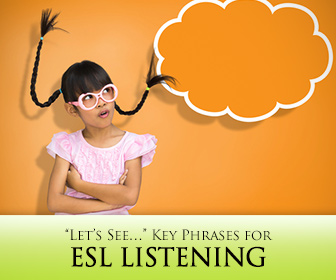“Let’s See…” Key Phrases for ESL Listening


A Catch-22 involves two contradictory outcomes, such as the one made famous in the novel by the same name: to get out of serving in the military, a soldier had to demonstrate he was insane, but if he wanted out of the military, he couldn’t be insane. There is a similar “Catch 22” for English Learners: to learn English, students need more practice speaking English, but to practice English with native speakers, they almost need to know English already. It is often noted that children learn second languages faster than adults, and while this may be true, a major reason may be that children simply have more opportunity to practice, in the form of play groups, where other children tend to welcome them with varying degrees of willingness. Adults, however, tend to find it much harder to approach a group of strangers and join in their conversation, which is hard in a first language, much less a second.
How then can the adult ESL student join these adult “play groups” (conversation groups) to gain needed practice in the second language? A way to do this is through the opening gambit.
An opening gambit serves several functions: it serves as a greeting, shows desire to join the group in conversation, and establishes a possible topic for conversation. An opening gambit may be as simple as “Hi, I’m Michelle. How are you this evening? Do you make it out here often?”
There are a number of other opening gambits of varying degrees of sophistication.

Traffic and weather are perennial topics with for opening gambits because they are neutral—few can take exception to me remarking on the heavy rain as it can’t be argued, and is no one’s fault. In addition, these rather flat topics can lead into more interesting terrain—a comment on the weather or traffic in Sacramento, for example, almost invites a comparison to weather and traffic in other cities the speakers have lived in, and they can in this way learn something about each other.
This can be a good opening gambit because it can lead to both a discussion of the immediate surroundings—for example, a bookstore-- as well as the addressee’s habits, such as reading habits. This can furthered be developed into comparisons of the two speakers’ reading habits, bookstores in general, and the conversion of traditional books to electronic material.
This is a good opening at a party, for example, when the speaker might ask the addressee how he or she knows the host. This then can lead to a discussion of the speakers’ mutual connections to the host through work, or school, or recreational activities, and they may then find shared interests.
This is an especially good opening gambit at a meeting for a professional, civic, or recreational organization, such as through a church or club. This gambit can lead into a discussion of the speakers’ histories with the organization as well as their reasons for being involved in it.
This is another good opening for the immediate context; for example, if the speakers are at a professional or civic meeting at which there is a presentation, one of the speakers might ask the other what she thinks of the presenter. This can lead into further, more in-depth conversation about the speakers’ philosophies and beliefs related to the organization: for example, if I am at a professional meeting of other teachers of English, and the presenter comes from a grammar-translation background—that is, teaching English with a heavy focus on translating to the students’ first language and analyzing the grammar—I might express my skepticism to someone who asks my thoughts on the presenter. This can lead to an interesting discussion on teaching methods and their history and effectiveness.

To teach opening gambits, as with almost anything, some explicit instruction is required at the beginning through definition and example in context so that students get a firm idea of what the concept means. The teacher can begin by asking students if they would just walk up to a group of strangers at a party and begin talking. Most will probably answer “no.” The teacher can then introduce a more effective strategy: joining a group, listening quietly for a time, then when the opportunity presents, entering the conversation by making a comment. This is the “opening gambit.”
Once students understand what the gambit is, it’s time to show its correct use. One way to do this is by modeling: write some of the common opening gambits on the board then call on a more advanced student choose and use one of the gambits, to which you respond appropriately. This of course can be reversed, with the instructor giving the gambit to the student. Finally, a short clip from a romantic comedy, for example, showing characters in a party scene can demonstrate use of the opening gambit—sometimes their inappropriate use, as well--which can be discussed.
Once students understand opening gambits and have seen them in action, they are ready for some guided conversations, with dialogues prepared by the teacher—or just the gambit, on an index card, to which students have to come up with responses. This step may also be skipped if students are prepared enough to move to the less structured and more independent roleplay.
In the roleplay, the teacher may just give out the general directions, the context and roles, and let the students go from there. For example: Get into groups of five. Four members are the conversation group. One member wants to join with a conversational gambit. Talk for 5 minutes then rotate roles. Everyone has to take the turn of the joiner with the gambit. In this strategy, because it is unstructured, students experience what it is like in a real situation where they will have to overcome discomfort to join a conversational group and there is no real script to guide them.
However, we all find ourselves in situations having to converse with people we don’t know, and careful use of the opening gambit makes this less stressful and may even lead to some long-term friendships beyond the immediate situation.